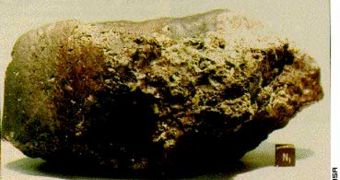A group of investigators suggests that what other researchers construed as sings of ancient Martian life in a meteorite that arrived to Earth from the Red Planet may in fact be explained through basic chemistry. This is only the last argument to be brought in a debate raging on for years.
In addition, the team says, the new explanation may also provide some insight into the complex chemical processes taking place in both the terrestrial and Martian atmospheres.
The international controversy is centered around a meteorite called ALH84001, which was determined to be around 3.9 billion years old. Analysis of its composition revealed that it came from Mars.
Naturally, the rock didn't simply fly away from the other planet's surface and rocketed straight here. It was most likely dislodged from its home world by a powerful cosmic impact with an asteroid.
Such blasts usually create ejecta cones so high, that debris within are able to defeat the planet's gravitational pull, and escape orbital insertion. They then begin to float freely through the solar system.
Planetary scientists believe that this is what happened to ALH84001 as well. Eventually, after traveling in space for millions of years, the odds were just right, and it made its way here.
The first analysis ever to be conducted on the object revealed the existence of microscale globular carbonate particles on its surface, which the team that carried out the study proposed were signs of ancient life forms that had once lived on Mars.
But the new research demonstrates through simple chemistry that carbonates may form on our planet without any sort of assistance and interference from biological organisms. The group also proposes that the same may hold true on the Red Planet as well.
One weird thing about the carbonates found on the space rock is that they contain a large amount of the isotope oxygen-17. Similarly high levels of this particular isotope were also found inside dust grains, aerosols and dirt produced here on Earth.
This is what led the team, led by University of California in San Diego (UCSD) atmospheric chemist Robina Shaheen, to conclude that a process shared by both planets may have formed the structures.
According to UCSD planetary scientist and researcher Mark Thiemens, while the new findings show that the meteorite did not carry signs of life, “that doesn't mean that life is impossible on Mars.”
One of the most important implications the new work carries has to do with better understanding our own planet, as well as the onset of the atmospheric processes and cycles that characterize it.
“The chemical transformations aerosols can undergo could make them seeds for cloud formation when before we thought they could not, which has huge implications regarding the water cycle and probabilities of rain,” Shaheen says, quoted by Space.

 14 DAY TRIAL //
14 DAY TRIAL //